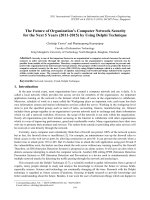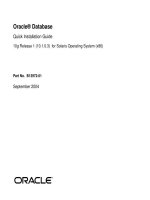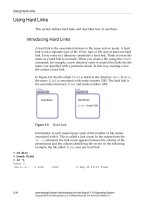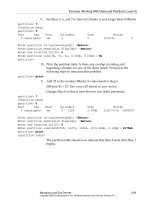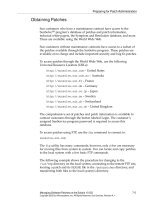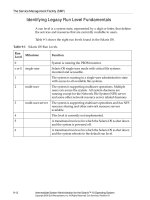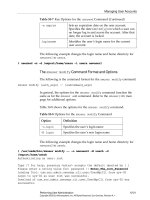Network Administration for the Solaris 9 Operating Environment SA399 Student Guide docx
Bạn đang xem bản rút gọn của tài liệu. Xem và tải ngay bản đầy đủ của tài liệu tại đây (3.88 MB, 598 trang )
Sun Microsystems, Inc.
UBRM05-104
500 Eldorado Blvd.
Broomfield, CO 80021
U.S.A.
Revision A
StudentGuide
Network Administration for the
Solaris™ 9 Operating
Environment
SA-399
June 20, 2002 1:51 pm
Please
Recycle
Copyright 2002 Sun Microsystems, Inc., 901 San Antonio Road, Palo Alto, California 94303, U.S.A. All rights reserved.
This product or document is protected by copyright and distributed under licenses restricting its use, copying, distribution, and
decompilation. No part of this product or document may be reproduced in any form by any means without prior written authorization of
Sun and its licensors, if any.
Third-party software, including font technology, is copyrighted and licensed from Sun suppliers.
Sun, Sun Microsystems, the Sun logo, JumpStart, OpenBoot, Solaris, Solstice DiskSuite, Sun Blade, Sun BluePrints, Sun Enterprise, Sun Fire,
Sun Quad FastEthernet, Sun StorEdge,Sun Trunking, and Ultra are trademarks or registered trademarks of Sun Microsystems, Inc. in the
U.S. and other countries.
All SPARC trademarks are used under license and are trademarks or registered trademarks of SPARC International, Inc. in the U.S. and
other countries. Products bearing SPARC trademarks are based upon an architecture developed by Sun Microsystems, Inc.
UNIX is a registered trademark in the U.S. and other countries, exclusively licensed through X/Open Company, Ltd.
The OPEN LOOK and Sun Graphical User Interface was developed by Sun Microsystems, Inc. for its users and licensees. Sun acknowledges
the pioneering efforts of Xerox in researching and developing the concept of visual or graphical user interfaces for the computer industry.
Sun holds a non-exclusive license from Xerox to the Xerox Graphical User Interface, which license also covers Sun’s licensees who
implement OPEN LOOK GUIs and otherwise comply with Sun’s written license agreements.
U.S. Government approval might be required when exporting the product.
RESTRICTED RIGHTS: Use, duplication, or disclosure by the U.S. Government is subject to restrictions of FAR 52.227-14(g)(2)(6/87) and
FAR 52.227-19(6/87), or DFAR 252.227-7015 (b)(6/95) and DFAR 227.7202-3(a).
DOCUMENTATION IS PROVIDED “AS IS” AND ALL EXPRESS OR IMPLIED CONDITIONS, REPRESENTATIONS, AND
WARRANTIES, INCLUDING ANY IMPLIED WARRANTY OF MERCHANTABILITY, FITNESS FOR A PARTICULAR PURPOSE OR
NON-INFRINGEMENT, ARE DISCLAIMED, EXCEPT TO THE EXTENT THAT SUCH DISCLAIMERS ARE HELD TO BE LEGALLY
INVALID.
THIS MANUAL IS DESIGNED TO SUPPORT AN INSTRUCTOR-LED TRAINING
(ILT) COURSE AND IS INTENDED TO BE USED FOR REFERENCE PURPOSES IN
CONJUNCTION WITH THE ILT COURSE. THE MANUAL IS NOT A STANDALONE
TRAINING TOOL. USE OF THE MANUAL FOR SELF-STUDY WITHOUT CLASS
ATTENDANCE IS NOT RECOMMENDED.
Export Control Classification Number (ECCN): 5E992
Please
Recycle
Copyright 2002 Sun Microsystems Inc., 901 San Antonio Road, Palo Alto, California 94303, Etats-Unis. Tous droits réservés.
Ce produit ou document est protégé par un copyright et distribué avec des licences qui en restreignent l’utilisation, la copie, la distribution,
et la décompilation. Aucune partie de ce produit ou document ne peut être reproduite sous aucune forme, par quelque moyen que ce soit,
sans l’autorisation préalable et écrite de Sun et de ses bailleurs de licence, s’il y en a.
Le logiciel détenu par des tiers, et qui comprend la technologie relative aux polices de caractères, est protégé par un copyright et licencié
par des fournisseurs de Sun.
Sun, Sun Microsystems, the Sun logo, JumpStart, OpenBoot, Solaris, Solstice DiskSuite, Sun Blade, Sun BluePrints, Sun Enterprise, Sun Fire,
Sun Quad FastEthernet, Sun StorEdge, Sun Trunking, et Ultra sont des marques de fabrique ou des marques déposées de Sun
Microsystems, Inc. aux Etats-Unis et dans d’autres pays.
Toutes les marques SPARC sont utilisées sous licence sont des marques de fabrique ou des marques déposées de SPARC International, Inc.
aux Etats-Unis et dans d’autres pays. Les produits portant les marques SPARC sont basés sur une architecture développée par Sun
Microsystems, Inc.
UNIX est une marques déposée aux Etats-Unis et dans d’autres pays et licenciée exclusivement par X/Open Company, Ltd.
L’interfaces d’utilisation graphique OPEN LOOK et Sun™ a été développée par Sun Microsystems, Inc. pour ses utilisateurs et licenciés.
Sun reconnaît les efforts de pionniers de Xerox pour larecherche et le développement du concept des interfaces d’utilisation visuelle ou
graphique pour l’industrie de l’informatique. Sun détient une licence non exclusive de Xerox sur l’interface d’utilisation graphique Xerox,
cette licence couvrant également les licenciés de Sun qui mettent en place l’interface d’utilisation graphique OPEN LOOK et qui en outre
se conforment aux licences écrites de Sun.
L’accord du gouvernement américain est requis avant l’exportation du produit.
LA DOCUMENTATION EST FOURNIE “EN L’ETAT” ET TOUTES AUTRES
CONDITIONS, DECLARATIONS ET GARANTIES EXPRESSES OU TACITES SONT
FORMELLEMENT EXCLUES, DANS LA MESURE AUTORISEE PAR LA LOI
APPLICABLE, Y COMPRIS NOTAMMENT TOUTE GARANTIE IMPLICITE RELATIVE
A LA QUALITE MARCHANDE, A L’APTITUDE A UNE UTILISATION PARTICULIERE
OU A L’ABSENCE DE CONTREFAÇON.
v
Copyright 2002 Sun Microsystems, Inc. All Rights Reserved. Enterprise Services, Revision A
Table of Contents
About This Course xv
Instructional Goals xv
Course Map xvi
Topics Not Covered xvii
How Prepared Are You? xviii
Introductions xix
How to Use Course Materials xx
Conventions xxi
Icons xxi
Typographical Conventions xxi
Introducing the TCP/IP Model 1-1
Objectives 1-1
Introducing Network Model Fundamentals 1-2
Network Protocols 1-2
Network Model Concepts 1-3
Introducing the Layers of the TCP/IP Model 1-4
Network Interface Layer 1-5
Internet Layer 1-6
Transport Layer 1-7
Application Layer 1-8
Describing Basic Peer-to-Peer Communication and Related
Protocols 1-10
Peer-to-Peer Communication 1-10
TCP/IP Protocols 1-11
Exercise: Reviewing the TCP/IP Model 1-15
Tasks 1-15
Exercise Summary 1-17
Exercise Solutions 1-18
vi Network Administration for the Solaris™ 9 Operating Environment
Copyright 2002 Sun Microsystems, Inc. All Rights Reserved. Enterprise Services, Revision A
Introducing LANs and Their Components 2-1
Objectives 2-1
Introducing Network Topologies 2-2
Bus Topologies 2-2
Star Topologies 2-3
Ring Topologies 2-4
VLAN Topologies 2-5
Introducing LAN Media 2-9
IEEE Identifiers 2-9
IEEE 802.3 Type 2-10
Introducing Network Devices 2-14
Shared Hubs 2-14
Bridges 2-14
Switches 2-14
Exercise: Reviewing LANs and Their Components 2-16
Preparation 2-16
Tasks 2-16
Exercise Summary 2-18
Exercise Solutions 2-19
Describing Ethernet Interfaces 3-1
Objectives 3-1
Introducing Ethernet Concepts 3-2
Major Ethernet Elements 3-2
CSMA/CD Access Method 3-2
Full-Duplex and Half-Duplex Transmission 3-4
Ethernet Statistics 3-4
Introducing Ethernet Frames 3-6
Ethernet Addresses 3-6
Setting a Local Ethernet Address 3-8
Ethernet-II Frame Analysis 3-10
Ethernet Frame Encapsulation 3-11
Maximum Transfer Units 3-13
Ethernet Frame Errors 3-14
Using Network Utilities 3-15
Using the snoop Utility 3-15
Using the netstat Utility 3-18
Using the ndd Utility 3-19
Exercise: Reviewing Ethernet Interfaces 3-22
Preparation 3-22
Tasks 3-22
Exercise Summary 3-26
Exercise Solutions 3-27
vii
Copyright 2002 Sun Microsystems, Inc. All Rights Reserved. Enterprise Services, Revision A
Describing ARP and RARP 4-1
Objectives 4-1
Introducing ARP 4-2
Purpose of ARP 4-2
Operation of ARP 4-3
Introducing RARP 4-7
Purpose of RARP 4-7
Operation of RARP 4-7
Exercise: Reviewing ARPs and RARPs 4-10
Preparation 4-10
Tasks 4-11
Exercise Summary 4-14
Exercise Solutions 4-15
Configuring IP 5-1
Objectives 5-1
Introducing the Internet Layer Protocols 5-2
Purpose of IP 5-2
Purpose of ICMP 5-3
Introducing the IP Datagram 5-5
IP Datagram Header Fields 5-5
IP Datagram Payload 5-6
Introducing IP Address Types 5-7
Unicast Addresses 5-7
Broadcast Addresses 5-8
Multicast Addresses 5-9
Introducing Subnetting and VLSM 5-10
Subnetting 5-10
The /etc/inet/netmasks File 5-11
VLSM 5-12
Introducing the Interface Configuration Files 5-14
The /etc/hostname.
interface
File 5-14
The /etc/inet/hosts File 5-14
The /etc/nodename File 5-15
Administering Logical Interfaces 5-16
Introducing Logical Interfaces 5-16
Configuring Logical Interfaces 5-17
Unconfiguring Logical Interfaces 5-20
Exercise: Reviewing IP 5-21
Preparation 5-21
Task Summary 5-21
Tasks 5-22
Exercise Summary 5-24
Exercise Solutions 5-25
viii Network Administration for the Solaris™ 9 Operating Environment
Copyright 2002 Sun Microsystems, Inc. All Rights Reserved. Enterprise Services, Revision A
Configuring Multipathing 6-1
Objectives 6-1
Increasing Network Throughput and Availability 6-2
Limitations of Network Interfaces 6-2
Implementing Multipathing 6-4
Introducing Multipathing 6-4
Configuring Multipathing Using Configuration Files 6-7
Configuring Multipathing Using the
Command Line 6-12
Viewing Multipath Operation 6-20
Troubleshooting a Multipath
Network Configuration 6-22
Exercise: Reviewing Multipathing 6-24
Preparation 6-24
Tasks 6-26
Exercise Summary 6-30
Exercise Solutions 6-31
Configuring Routing 7-1
Objectives 7-1
Identifying the Fundamentals of Routing 7-2
Purpose of Routing 7-2
Routing Types 7-3
Introducing Route Table Population 7-4
Static Route 7-4
Dynamic Route 7-4
Introducing Routing Protocol Types 7-6
Autonomous Systems 7-6
Interior Routing Protocols 7-7
Exterior Routing Protocols 7-8
Introducing the Route Table 7-9
Displaying the Route Table 7-9
Introducing Route Table Entries 7-10
Introducing Route Table Search Order 7-12
Associating Network Name and Network Number 7-14
Configuring Static Routes 7-16
Configuring Static Direct Routes 7-16
Configuring the /etc/defaultrouter File 7-16
Configuring the /etc/gateways File 7-17
Configuring Manual Static Routes 7-18
Using the RDISC Protocol 7-21
Configuring Dynamic Routing 7-23
RIP Version 1 7-23
The in.routed Process 7-25
ICMP (Routing) Redirect 7-26
ix
Copyright 2002 Sun Microsystems, Inc. All Rights Reserved. Enterprise Services, Revision A
Introducing CIDR 7-28
Purpose of CIDR 7-28
Operation of CIDR 7-28
Configuring Routing at Boot Time 7-32
Initializing the Router 7-32
Configuring the Router Without Rebooting 7-34
Initializing a Multihomed Host 7-34
Initializing a Non-Router 7-36
Troubleshooting Routing 7-37
Troubleshooting the Router Configuration 7-37
Troubleshooting Network Names 7-39
Exercise: Reviewing Routing Configuration 7-40
Preparation 7-40
Tasks 7-42
Exercise Summary 7-53
Exercise Solutions 7-54
Configuring IPv6 8-1
Objectives 8-1
Introducing IPv6 8-2
The Need for IPv6 8-2
Features of IPv6 8-3
Introducing IPv6 Addressing 8-4
Address Types 8-4
IPv6 Address Representation 8-5
Format Prefixes 8-5
Introducing IPv6 Autoconfiguration 8-7
Stateful Autoconfiguration 8-7
Stateless Autoconfiguration 8-7
Interface Identifier Calculation 8-8
Duplicate Address Detection 8-9
Introducing Unicast Address Types 8-10
Link-Local Address Types 8-10
Site-Local Address Types 8-10
Aggregatable Global Unicast Address Types 8-11
Prefix Notation 8-11
Embedded IPv4 Addresses 8-12
Unspecified Address Types 8-12
Loopback Address Types 8-12
Introducing Multicast Address Types 8-13
Purpose of Multicast Addresses 8-13
Scope Bits 8-14
ICMPv6 Group Membership 8-15
Enabling IPv6 8-16
The in.ndpd Process on the Non-Router 8-16
IPv6 on Non-Routers Configuration 8-17
x Network Administration for the Solaris™ 9 Operating Environment
Copyright 2002 Sun Microsystems, Inc. All Rights Reserved. Enterprise Services, Revision A
Non-Router Configuration Troubleshooting 8-20
The in.ndpd Process on the Router 8-21
IPv6 Routing Information Protocol 8-21
IPv6 Router Configuration 8-22
Router Configuration Troubleshooting 8-26
Managing IPv6 8-28
Displaying the State of IPv6 Interfaces 8-28
Modifying an IPv6 Interface Configuration 8-28
Configuring Logical Interfaces 8-29
Troubleshooting IPv6 Interfaces 8-29
Displaying the IPv6 Route Table 8-29
Exercise: Configuring IPv6 8-30
Preparation 8-30
Tasks 8-30
Exercise Summary 8-36
Exercise Solutions 8-37
Configuring IPv6 Multipathing 8-47
Configuring IPMP Manually 8-47
Configuring IPMP at Boot Time 8-57
Exercise: Configuring IPv6 Multipathing 8-61
Preparation 8-61
Tasks 8-61
Exercise Summary 8-64
Exercise Solutions 8-65
Configuring IPv6-Over-IPv4 Tunnels 8-70
Introducing Tunnels 8-70
Configuring Tunnels 8-70
Routing Between Tunnels 8-77
Troubleshooting IPv4 Tunnels 8-77
Exercise: Configuring an IPv6-Over-IPv4 Tunnel 8-79
Preparation 8-79
Tasks 8-79
Exercise Summary 8-81
Exercise Solutions 8-82
Describing the Transport Layer 9-1
Objectives 9-1
Introducing Transport Layer Fundamentals 9-2
Protocol Characteristics 9-2
Transport Protocols in TCP/IP 9-8
Introducing UDP 9-9
Purpose of UDP 9-9
UDP Datagram Header 9-9
Introducing TCP 9-10
TCP Segment Header 9-10
Virtual Circuit Connection 9-11
xi
Copyright 2002 Sun Microsystems, Inc. All Rights Reserved. Enterprise Services, Revision A
Full-Duplex Connection 9-11
Unstructured Stream Orientation 9-11
Buffered Transfer 9-11
Introducing TCP Flow Control 9-12
Receiver-Side Window Advertisements 9-12
Sender-Side Congestion Window 9-12
TCP Large Window 9-13
Exercise: Describing the Transport Layer 9-14
Preparation 9-14
Tasks 9-14
Exercise Summary 9-15
Exercise Solutions 9-16
Configuring DNS 10-1
Objectives 10-1
Introducing DNS Basics 10-2
BIND 10-2
Top-Level Domains 10-2
Zones of Authority 10-4
Server Types 10-4
Answer Types 10-7
Name-Resolution Process 10-7
Resource Records 10-10
Configuring the DNS Server 10-14
Gathering Information 10-14
Editing the BIND Configuration File 10-14
Editing the named.root File 10-17
Editing the Forward-Domain File 10-19
Editing the Reverse-Domain File 10-21
Editing the Reverse-Loopback Domain File 10-22
Configuring Dynamic Updates 10-23
Configuring Security 10-23
Configuring Secondary DNS Servers 10-25
Configuring DNS Clients 10-26
Troubleshooting the DNS Server Using Basic Utilities 10-28
Examining the/var/adm/messages File 10-28
Using the nslookup Utility 10-29
Dumping a Snapshot of the DNS Database 10-31
Changing the Debug Level of the Name Daemon 10-31
Forcing the in.named Process to Reread Configuration Files .
10-32
Modifying the DNS Server With the ndc Utility 10-32
Exercise: Configuring DNS 10-34
Preparation 10-34
Task Summary 10-34
Tasks 10-35
Exercise Summary 10-41
Exercise Solutions 10-42
xii Network Administration for the Solaris™ 9 Operating Environment
Copyright 2002 Sun Microsystems, Inc. All Rights Reserved. Enterprise Services, Revision A
Configuring DHCP 11-1
Objectives 11-1
Introducing the Fundamentals of DHCP 11-2
Purpose of DHCP 11-2
DHCP Client Functions 11-3
DHCP Server Functions 11-4
Configuring a DHCP Server 11-6
Configuring DHCP Using Different Methods 11-7
Using the dhcpconfig Utility 11-7
Introducing the dhcp_
network
File 11-9
Using the pntadm Utility 11-10
Introducing the dhcptab Table 11-13
Performing Initial DHCP Server Configuration by
Using the dhcpmgr Utility 11-17
Adding Addresses by Using the dhcpmgr Utility 11-29
Configuring and Managing DHCP Clients 11-37
Configuring the DHCP Client 11-37
Exercise: Configuring a DHCP Server and Client 11-39
Preparation 11-39
Task Summary 11-39
Tasks 11-39
Exercise Summary 11-42
Exercise Solutions 11-43
Task 1 – Configuring the DHCP Server 11-43
Task 2 – Configuring the DHCP Client 11-61
Task 3 – Using the snoop Utility to View DHCP
Client-Server Interaction 11-62
Configuring for Dynamic DNS 11-64
Viewing Debug Output From the DNS Server 11-67
Troubleshooting the DHCP Server 11-68
Troubleshooting DHCP Clients 11-72
Troubleshooting DHCP Client Host
Name Acquisition 11-72
Configuring the DHCP Server to Support
JumpStart Clients 11-80
Comparing Conventional JumpStart Procedure
With DHCP JumpStart Procedure Clients 11-80
Performing a Configuration 11-80
Configuring a DHCP Server to Allow a Client to
Boot From a JumpStart Server 11-86
Configuring the JumpStart Server to Support
JumpStart in DHCP 11-106
Testing the Client’s Ability to Jump Start by
Using DHCP 11-107
xiii
Copyright 2002 Sun Microsystems, Inc. All Rights Reserved. Enterprise Services, Revision A
Exercise: Configuring a DHCP Server and Client 11-109
Preparation 11-109
Task Summary 11-109
Tasks 11-110
Exercise Summary 11-112
Exercise Solutions 11-113
Task 1 – Configuring DNS to Support Dynamic
DNS Updates 11-113
Task 2 – Configuring the DHCP Server to Perform
Dynamic DNS Updates 11-113
Task 3 – Configuring the DHCP Server to Allow a
Client to Boot from a JumpStart Server 11-116
Configuring NTP 12-1
Objectives 12-1
Identifying NTP Basics 12-2
How Computers Keep Time 12-2
Uses of NTP 12-3
NTP Terms 12-3
Configuring an NTP Server 12-5
Using an Undisciplined Local Clock 12-7
Using External NTP Reference Servers 12-9
Managing Daemons 12-10
Determining NTP Peers 12-11
Configuring an NTP Client 12-12
Establishing Basic Configuration 12-12
Managing NTP Client Daemons 12-13
Troubleshooting NTP 12-14
Viewing Messages 12-14
Using the snoop Utility 12-15
Exercise: Configuring NTP 12-16
Preparation 12-16
Task Summary 12-16
Tasks 12-16
Exercise Summary 12-19
Exercise Solutions 12-20
Bibliography Bibliography-1
Sun Microsystems Publications Bibliography-1
Books Bibliography-1
Online References Bibliography-2
Requests for Comments (RFCs) Bibliography-3
Glossary/Acronyms Glossary-1
Index Index-1
Copyright 2002 Sun Microsystems, Inc. All Rights Reserved. Enterprise Services, Revision A
Preface
AboutThisCourse
Instructional Goals
Upon completion of this course, you should be able to:
● Configure the Network Interface layer
● Configure the network (Internet and Transport layers)
● Configure and manage network applications
Course Map
Preface-xvi Network Administration for the Solaris™ 9 Operating Environment
Copyright 2002 Sun Microsystems, Inc. All Rights Reserved. Enterprise Services, Revision A
Course Map
The course map enables you to see what you have accomplished and
where you are going in reference to the instructional goals.
Topics Not Covered
About This Course Preface-xvii
Copyright 2002 Sun Microsystems, Inc. All Rights Reserved. Enterprise Services, Revision A
Topics Not Covered
This course does not cover the following topics. Many of these topics are
covered in other courses offered by Sun Educational Services:
● Solaris™ Operating Environment (Solaris OE) system
administration – Covered in SA-239: Intermediate System
Administration for the Solaris™ 9 Operating Environment and
SA-299: Advanced System Administration for the Solaris™ 9 Operating
Environment
● Server storage administration – Covered in ES-220: Disk Management
with DiskSuite™ and ES-310: Volume Manager With Sun StorEdge™
● NIS+ – Covered in SA-385: NIS+ Administration
● Solaris OE tuning – Covered in SA-400: Solaris™ Systems Performance
Management
Refer to the Sun Educational Services catalog for specific information and
registration.
How Prepared Are You?
Preface-xviii Network Administration for the Solaris™ 9 Operating Environment
Copyright 2002 Sun Microsystems, Inc. All Rights Reserved. Enterprise Services, Revision A
How Prepared Are You?
To be sure you are prepared to take this course, can you answer yes to the
following questions?
● Can you perform basic host operations, such as startup and
shutdown, to initialize certain network configuration changes?
● Can you manipulate startup and shutdown scripts to configure
networks?
● Can you set up user accounts when configuring network services for
system users?
● Can you locate and install network software packages required to set
up various network services?
Introductions
About This Course Preface-xix
Copyright 2002 Sun Microsystems, Inc. All Rights Reserved. Enterprise Services, Revision A
Introductions
Now that you have been introduced to the course, introduce yourself to
the other students and the instructor, addressing the following items:
● Name
● Company affiliation
● Title, function, and job responsibility
● Experience related to topics presented in this course
● Reasons for enrolling in this course
● Expectations for this course
How to Use Course Materials
Preface-xx Network Administration for the Solaris™ 9 Operating Environment
Copyright 2002 Sun Microsystems, Inc. All Rights Reserved. Enterprise Services, Revision A
How to Use Course Materials
To enable you to succeed in this course, these course materials employ a
learning module that is composed of the following components:
● Objectives – You should be able to accomplish the objectives after
completing a portion of instructional content. Objectives support
goals and can support other higher-level objectives.
● Lecture – The instructor will present information specific to the
objective of the module. This information will help you learn the
knowledge and skills necessary to succeed with the activities.
● Activities – The activities take on various forms, such as an exercise,
self-check, discussion, and demonstration. Activities are used to
facilitate mastery of an objective.
● Visual aids – The instructor might use several visual aids to convey a
concept, such as a process, in a visual form. Visual aids commonly
contain graphics, animation, and video.
Note – Many system administration tasks for the Solaris OE can be
accomplished in more than one way. The methods presented in the
courseware reflect recommended practices used by Sun Educational
Services.
Conventions
About This Course Preface-xxi
Copyright 2002 Sun Microsystems, Inc. All Rights Reserved. Enterprise Services, Revision A
Conventions
The following conventions are used in this course to represent various
training elements and alternative learning resources.
Icons
?
!
Discussion – Indicates a small-group or class discussion on the current
topic is recommended at this time.
Note – Indicates additional information that can help students but is not
crucial to their understanding of the concept being described. Students
should be able to understand the concept or complete the task without
this information. Examples of notational information include keyword
shortcuts and minor system adjustments.
Caution – Indicates that there is a risk of personal injury from a
nonelectrical hazard, or risk of irreversible damage to data, software, or
the operating system. A caution indicates that the possibility of a hazard
(as opposed to certainty) might happen, depending on the action of the
user.
Typographical Conventions
Courier is used for the names of commands, files, directories, user
names, host names, programming code, and on-screen computer output;
for example:
Use the ls -al command to list all files.
host1# cd /home
Courier bold is used for characters and numbers that you type; for
example:
To list the files in this directory, type the following:
# ls
Conventions
Preface-xxii Network Administration for the Solaris™ 9 Operating Environment
Copyright 2002 Sun Microsystems, Inc. All Rights Reserved. Enterprise Services, Revision A
Courier italics
is used for variables and command-line placeholders
that are replaced with a real name or value; for example:
To delete a file, use the rm
filename
command.
Courier italic bold
is used to represent variables whose values are to
be entered by the student as part of an activity; for example:
Type chmod a+rwx
filename
to grant read, write, and execute
rights for
filename
.
Palatino italics is used for book titles, new words or terms, or words that
you want to emphasize; for example:
Read Chapter 6 in the User’s Guide.
These are called class options.
1-1
Copyright 2002 Sun Microsystems, Inc. All Rights Reserved. Enterprise Services, Revision A
Module 1
IntroducingtheTCP/IPModel
Objectives
This module describes the fundamentals of the Transmission Control
Protocol/Internet Protocol (TCP/IP) model, including network protocols
and concepts. This module also describes the layers of the TCP/IP model,
including the Network Interface, Internet, Transport, and Application
layers. This module also describes basic peer-to-peer communication and
some common TCP/IP protocols.
Upon completion of this module, you should be able to:
● Describe network model fundamentals
● Describe the layers of the TCP/IP model
● Describe basic peer-to-peer communication and related protocols
The following course map shows how this module fits into the current
instructional goal.
Figure 1-1 Course Map
Introducing Network Model Fundamentals
1-2 Network Administration for the Solaris™ 9 Operating Environment
Copyright 2002 Sun Microsystems, Inc. All Rights Reserved. Enterprise Services, Revision A
Introducing Network Model Fundamentals
The fundamentals required to understand computer networking are the
network model, the functions of the layers, and the protocols that govern
data transfer between two or more systems.
Network Protocols
Computer networks use protocols to communicate. Protocols define the
procedures to be followed by the systems involved in the communication
process. A data communication protocol is a set of rules that must be
followed for two electronic devices to communicate with each other.
These rules describe:
● Syntax – Data format and coding
● Semantics – Control information and error handling
● Timing – Speed matching and sequencing
Functions of Protocols
A protocol defines how systems can communicate and facilitates
communication between software, firmware, and other devices in data
transfer.
Each protocol provides a function essential for data communication. Each
software module that implements a protocol can be developed and
updated independently of other modules, as long as the interface between
the modules remains constant.
Many protocols provide and support data communication. Many
protocols are used so that communication can be broken into smaller,
manageable processes. They form a communication architecture, also
known as a protocol stack. The TCP/IP model is a protocol stack used by
the Solaris™ Operating Environment (Solaris OE) for data
communication.
Introducing Network Model Fundamentals
Introducing the TCP/IP Model 1-3
Copyright 2002 Sun Microsystems, Inc. All Rights Reserved. Enterprise Services, Revision A
The features of a protocol stack are:
● Each layer has a specific purpose and exists on both the source
and destination hosts.
● Each layer communicates with a peer layer on another host in a
given process of communication.
● Each layer on a host acts independently of other layers on the
same machine but is synchronous with the same layer on other
hosts.
Network Model Concepts
A networking model refers to a common structure that enables
communication between two or more systems.
Networking models consist of layers. You can think of layers as a series of
steps or functions that must be sequentially completed for communication
to occur between two systems.
The following mapping helps you better understand the network model:
● Model = structure
● Layer = functions
● Protocol = rules
Advantages of Using a Layered Model
Some of the advantages of a layered model are that it:
● Divides the complexity of networking into many functions or layers
● Enables you to introduce changes or new features in one layer
without having to change the other layers
● Provides a standard to follow, allowing inter-operability between
software and hardware vendors
● Simplifies troubleshooting
